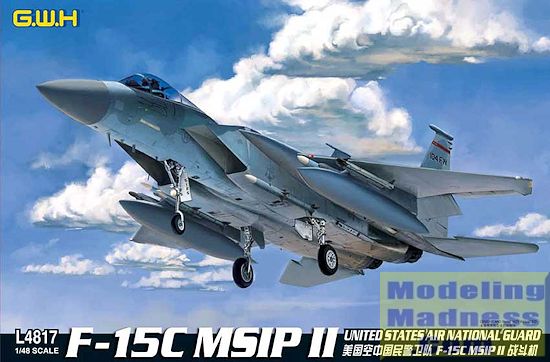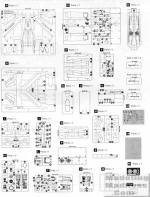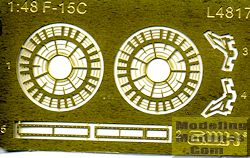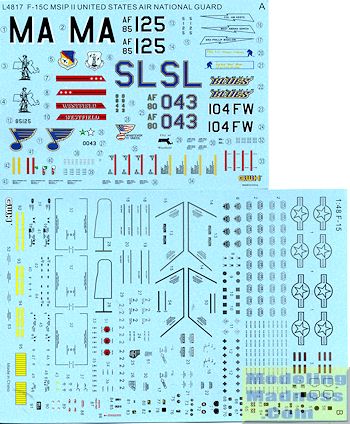
| KIT #: | L4817 |
| PRICE: | $109.95 SRP |
| DECALS: | Two options |
| REVIEWER: | Scott Van Aken |
| NOTES: |

| HISTORY |
The McDonnell Douglas (now Boeing) F-15 Eagle is a twin-engine, all-weather tactical fighter designed by McDonnell Douglas to gain and maintain air superiority in aerial combat. It is considered among the most successful modern fighters, with over 100 aerial combat victories with no losses in dogfights. Following reviews of proposals, the United States Air Force selected McDonnell Douglas' design in 1967 to meet the service's need for a dedicated air superiority fighter. The Eagle first flew in July 1972, and entered service in 1976.
Since the 1970s, the Eagle has been exported to Israel, Japan, Saudi Arabia, and other nations. The F-15 was originally envisioned as a pure air superiority aircraft. Its design included a secondary ground-attack capability that was largely unused. The design proved flexible enough that an all-weather strike derivative, the F-15E Strike Eagle, was later developed, and entered service in 1989. The F-15 Eagle is expected to be in service with the U.S. Air Force past 2025. F-15 versions are still being produced for foreign users, with the F-15 production line set to end in 2019, 47 years after the type's first flight.
| THE KIT |
 The last really good 1/48 F-15 kit to be produced was Revell's F-15E Strike Eagle. Unfortunately for many modelers, that was it so one had to rely on the older, but still nice kits from Hasegawa and Academy for their big Eagle Fix when it came to other versions. Both Revell and Monogram have also produced the F-15, but those are even older molds, though they are perfect for those on a budget.
The last really good 1/48 F-15 kit to be produced was Revell's F-15E Strike Eagle. Unfortunately for many modelers, that was it so one had to rely on the older, but still nice kits from Hasegawa and Academy for their big Eagle Fix when it came to other versions. Both Revell and Monogram have also produced the F-15, but those are even older molds, though they are perfect for those on a budget.
If you are familiar with any of the other GWH 1/48 kits, you know that they provide a great deal of detail. This kit is no exception. Let me start with the easy stuff. First off, there is a small photo etch fret included. This fret contains two pieces to go to the rear of the engine, a pair of slime light panels for the rear fuselage and a gun sight. There is also an acetate sheet for the clear part of the sight.
As is the norm with Eagles, the front cockpit and nose section is separate from the rear fuselage. The cockpit section is split vertically and the rear fuselage horizontally. As you'll have to clean up a seam, it is why the slime lights on the rear fuselage are not molded on. The cockpit is well detailed with raised detail on the instrument panels and side consoles. There are decals for each of the instrument. The bang seat is an Aces II seat that has nice detail, but a resin replacement will probably have more. There are interior sides that will fit onto the sides of the cockpit tub. A separate nose cone is provided so you can show off the radar, though it leaves little room for any weight you may want to add. The avionics panels on either side of the nose are separate and there is black box detail molded into the forward fuselage sections for those who like to have things opened up. A full set of avionics boxes behind the pilot's seat is an addition to this molding with separate handles for each of the boxes.
Moving to the rear fuselage, there are two piece full intakes that lead to complete engines. You can position the air intakes either raised or lowered. Normally these are lowered with the engine is running on the ground. You are provided with a pair of F-100-PW-220 engines to fit into the rear fuselage and these, along with their burner cans, can be inserted once the fuselage is together. There are separate flaps and slats though they seem to be something one has to glue in the neutral position.
As expected, the speed brake is separate and can be posed raised, though it rarely is when on the ground except to show off to crowds at shows. The canopy can also be posed raised or lowered. At the rear are single piece stabilizers and tail fins with separate rudders. The small counterbalances/RWR antennas atop the fin are separate pieces as well. Landing gear and wheels are nicely done. The gear doors can be installed up or down and most of you who have seen F-15s on the ground realize that many of these doors are normally up unless maintenance is being done in the wells.
The kit comes with a great selection of dangly things that includes a centerline and fuselage drop tanks. The weapons load includes a suite of US missiles that include Sidewinders, Sparrows and AIM-120s. As with their MiG-29 kits, these missiles are individually packaged in a nice blister pack to prevent damage. The only load-out you can model is two fuselage Sparrows along with one AIM-9 and one AIM-120 on each wing pylon.
 Instructions are just superb. It is GWH's usual book style and includes clearly drawn illustrations that provide all the markings and painting information. There are four full pages for stencil markings and one for missile/pylon/tank markings. With all these pages, you'd think there would be a lot of decals. There are. There are four huge pages for the markings placement, three of them are 1/48 scale and are dedicated to stencils. The two units in the sheet are for the box art plane from the 131 FS. Massachusetts ANG, which is still flying the plane and used to fly the A-10. In fact, it took over the planes of the 101 FS when it was deactivated in 2005. The other is from the 110 FS, Missouri ANG, which now has no planes and is incorporated with the 509 BW at Whiteman AFB. This plane has a special tail marking honoring the St. Louis Blues hockey team. The colors given for these planes in the instructions is incorrect, calling for FS 35237 and FS 36270. The F-15 has been wearing what is known as the 'Mod Eagle' scheme of FS 36176 and FS 36251 for about 20 years. I think the incorrect colors were chosen as Gunze does not have the proper ones in its catalogue. Testors does have them in its Model Master line and they are available from other paint lines as well.
Instructions are just superb. It is GWH's usual book style and includes clearly drawn illustrations that provide all the markings and painting information. There are four full pages for stencil markings and one for missile/pylon/tank markings. With all these pages, you'd think there would be a lot of decals. There are. There are four huge pages for the markings placement, three of them are 1/48 scale and are dedicated to stencils. The two units in the sheet are for the box art plane from the 131 FS. Massachusetts ANG, which is still flying the plane and used to fly the A-10. In fact, it took over the planes of the 101 FS when it was deactivated in 2005. The other is from the 110 FS, Missouri ANG, which now has no planes and is incorporated with the 509 BW at Whiteman AFB. This plane has a special tail marking honoring the St. Louis Blues hockey team. The colors given for these planes in the instructions is incorrect, calling for FS 35237 and FS 36270. The F-15 has been wearing what is known as the 'Mod Eagle' scheme of FS 36176 and FS 36251 for about 20 years. I think the incorrect colors were chosen as Gunze does not have the proper ones in its catalogue. Testors does have them in its Model Master line and they are available from other paint lines as well.
| CONCLUSIONS |
From what I understand, the few issues that were apparent on the two seat kit released earlier have been dealt with on this one. However, I am not an expert on the type so cannot say for sure. I do know that this is the most detailed F-15 kit I have seen in this scale and it has the benefit of being the latest fit, something one cannot say about the others out there. It very much seems to have Iclipsed what went before and will certainly make into a superb model when finished.
| REFERENCES |
http://en.wikipedia.org/wiki/F-15_Eagle
November 2014 Thanks to Great Wall Hobby (GWH) for the review kit. You can find this kit at your favorite hobby shop or on-line retailer. If you would like your product reviewed fairly and fairly quickly, please contactthe editor or see other details in the